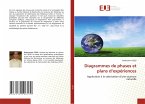Il est souvent nécessaire de réaliser des expériences afin de modéliser le comportement d'un phénomène complexe. La méthode des plans d'expérience a pour objectif d'obtenir un maximum d'information sur le phénomène étudié en un minimum d'expériences. Ceci est primordial si l'objectif est un gain de temps ou de qualité. Cet ouvrage détaille les fondements théoriques de la méthode mathématique des plans d'expérience. Ceci est abordé tout au long des quatre parties suivantes. Présentation générale de la méthode et des outils mathématiques. Plans d'expérience pour facteurs quantitatifs : modèle d'ordre un, modèle à effets d'interactions, surface de réponse, modèle à effets de blocs et modèle pour mélanges. Plans d'expérience pour facteurs qualitatifs : modèle additif, modèle à effets d'interactions et modèle à effets de blocs. Efficacité et optimalité : optimalité uniforme, A, D et E-efficacité, généralisation à la notion de Fq-efficacité, optimalité universelle. De nombreuxexemples sont utilisés afin d'illustrer les diverses techniques présentées. Les démonstrations mathématiques de la plupart des résultats énoncés figurent en annexe.
When a complex phenomenon is studied it is common to run experiments in order to fit a model. In such situations experimental designs can be used to find a maximum of information in a minimum of trials. This is of prime importance when the goal is to save time or improve quality. This book is structured in four parts: a general presentation of the method and mathematical background, experimental designs for
quantitative factors, experimental designs for qualitative factors, and optimality of experimental designs. Numerous examples are introduced in order to illustrate the applications and mathematical proofs for most of the results are given in appendices.
When a complex phenomenon is studied it is common to run experiments in order to fit a model. In such situations experimental designs can be used to find a maximum of information in a minimum of trials. This is of prime importance when the goal is to save time or improve quality. This book is structured in four parts: a general presentation of the method and mathematical background, experimental designs for
quantitative factors, experimental designs for qualitative factors, and optimality of experimental designs. Numerous examples are introduced in order to illustrate the applications and mathematical proofs for most of the results are given in appendices.
From the reviews:
"The design of experiments, the subject matter of this book ... is a very important and useful component of statistics and has been extensively used in numerous fields such as medicine, agriculture, education, engineering and technology, etc. ... The book has a useful index set, and a bibliography at the end. ... a well-written book presenting the basic and fundamentals of experimental designs in an easy-to-understand and accessible style. A salient feature of the book is the inclusion of numerous illustrative examples scattered throughout." (D. V. Chopra, Mathematical Reviews, Issue 2011 g)
"The design of experiments, the subject matter of this book ... is a very important and useful component of statistics and has been extensively used in numerous fields such as medicine, agriculture, education, engineering and technology, etc. ... The book has a useful index set, and a bibliography at the end. ... a well-written book presenting the basic and fundamentals of experimental designs in an easy-to-understand and accessible style. A salient feature of the book is the inclusion of numerous illustrative examples scattered throughout." (D. V. Chopra, Mathematical Reviews, Issue 2011 g)








